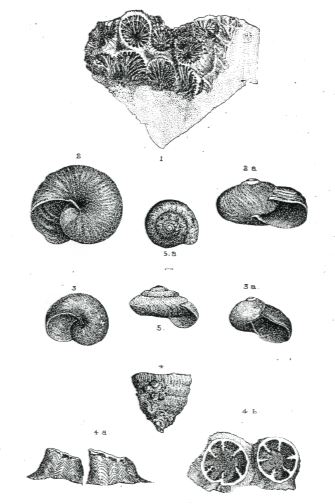page 123
ON TWO NEW SPECIES OF LAND SHELLS
By the Rev. J. E. TENISON-WOODS, F.L.S., F.G.S., Hon. Cor. Mem. Linn. Soc. N.S.W. Plate 12, Figs. 2. 3. 5.
The following new species were placed in my hands for description by Dr. James C. Cox, F.L.S. The first is from Tasmania. A medium sized form, very closely allied to Helix atramentaria, of the Dandenong Ranges, Victoria. In color, enamel, and the form of the embryo it is very similar, but it is smaller, more sloping, less discoid, and of fewer whorls. I have figured both species on the accompanying plate, so that the differences may be seen at a glance. It is very desirable that the animal should be studied, as the highly enamelled exterior surface, which is also smooth, renders it probable that the Victorian shell is also a Helicarion, with a caudal gland. The membranaceous edge makes it very probable. It should be observed that without a knowledge of the animals Albers * places our Australian Vitrinoe as Helicarion. This genus was established by Ferussac in 1821, for the Australian H. Freycineti † G. B. Sowerby subsequently united it to Vitrina. Latreille, Blainville, and Sander Rang regarded it only as a sub-genus. Menke, in 1830, and Beck, in 1837,‡ revived the genus, which is thus defined by Adams:- "Mantle with two free lobes in front on the
* Die Heliceen, Leipsic, 1860, 2 edit., by Von. Martens, p. 46. Helicarion is made a subgenus of Nanina, Gray.
† See Voy. de Freycinet, Zool., p. 465.
‡ Index Moll., Prince Christian Frederic, p. 2.
page 124
neck, and a large lobe on the right side covering the hind part of the shell; foot truncate posteriorly; shell rotundately oval, heliciform, thin, fragile, covered with a thin epidermis; spire short, aperture large, peritreme simple, acute, straight. The species of this genus have an extensive fold of the mantle developed on the right side. Their foot is truncate, and their shells are very thin." Vol. 2, p. 226. The general resemblance of this shell in color, &c., to those which are clearly of the genus Helicarion, induces me thus to classify it:-
HELICARION FUMOSA, n.s., Pl. 12, fig. 3, 3a.
H. t. umbilicata, turbinato-discoidea, tenuiuscula, politissima, lineis incrementi rugulosa, intense fumoso-cornea vel subnigra, unicolor (apice excluso,) translucente; spira parum exserta, apice prominulo, sutura subtillisime corrugata; anfr. 3 1/2, rapide accrescentib. Embryonales 1 1/3, albidi, ultimo valde declivo-rotundato, basi rolundata; apertura quasi orbiculata. Peristoma corneum, simplex, obtusum, incurvatum, marginibus ab umbilico usque ad 1/3 ultimi anfractus disjunctis: Columella acuta, declivis. Umbilicus angustissimus, profundus.
Diam. maj. 22, min 14, alt 18, millim.
OBS. Sp. eleganter polita, et intense subnigra saturata, forma vero, colore et aspectu, H. ATRAMENTARLAE, Pfr. Dandenong Ranges, Victoria, incolanti, valde proxima.
Shell umbilicate, turbinately discoid, rather thin, highly polished, uneven from the lines of growth, intensely smoky horn color or nearly black throughout except at the apex, translucent, spire somewhat exsert, with the apex very slightly prominent, suture very finely corrugated; whorls 3 1/2 increasing rapidly; embryonal 1 1/3, whitish, last whorl largely rounded and sloping, aperture almost orbicular. Peristome horny, obtuse, incurved, margins disjoined from the umbilicus for about 1/3 of the last whorl. Columella acute, sloping, umbilicus very narrow and deep.
This species is elegantly polished, and of an intense dark smoky brown, but in its shape, color, and general habit it is very close to H. atramentaria, Pfr. but that it is much smaller. There is a peculiar in-turning of the horny margin, which makes it rounded and blunt.
page 125
The next species is a very small shell from Victoria, closely resembling H. mucosa Cox of N. S. Wales.
HELIX MUCOIDES, n.s., Pl. 12, fig. 5, 5a.
H.t. minuta, late umbilicata, depressa, orbiculata, vix discoidea, solidiuscula, nitente vel quasi oleo inuncta, crebre corrugata, vel irregulariter striata, corneo-lutea, unicolor, translucens. Spira exserta, apice prominulo, obtuso. Sutura haud impressa. Anfr. 4 1/2, rotundatis, sensim accrescentibus, ultimo superne planato et obtuse carinato. Basi convexa, ut supra rugose striata sed subtiliori, et (sub lente tantum visis) subtilissime creberrimeque spiraliter liratis. Umbilico eprspectivo, vix 1/3 diam. testoe oequanti. Apertura subquadrata, intus pallidissime coeruleo-albida. Peristoma simplici, marginibus obtusis, haud appraximatis, columella parum expansa et reflexa. Testa maculis fuliginosis magnis et irregularibus plus minusve insignita. Forma et colore H. MUCOSAE proxima, minuta vero et inconspicua. Diam. maj. 3, min. 2 1/2, alt. 1 1/2 millim.
Shell minute, widely umbilicate, depressed, orbicular but hardly discoid, rather solid, shining as if from oil, very closely corrugated or irregularly striate, yellowish horn, of one uniform color and translucent. Spire exsert, apex slightly prominent, obtuse. Suture not impressed. Whorls 4 1/2, rounded, increasing gradually, the last flat above and obtusely keeled. Base convex and rugosely striate as above, but more finely, and under the lens seen to be closely, very finely spirally lirate. Umbilicus perspective, scarcely 1/3 the diameter of the shell. Aperture subquadrate, a very pale blueish white within. Peristome simple with obtuse margins which are not approximate. Columella slightly expanded and reflected. The shell is more or less marked with large irregular sooty patches.
H. mucosa, which it resembles is a very rare shell, but much larger, and the rugose striae are proportionately much smaller. With this shell was associated H. melbournensis Cox, and H. julioidea Cox. The latter is a Tasmanian species, but I could see no appreciable difference between the Melbourne specimens and those coming from Mount Wellington.
page 126
EXPLANATION OF FIGURES.
PLATE 12.
Fig. 2, 2a, Helix atramentaria, for comparison with fig. 3, 3a, Helicarion fumosa - both natural size.
Fig. 5, 5a, Helix mucoides, much enlarged.
